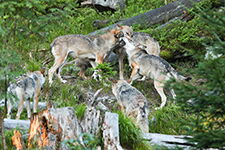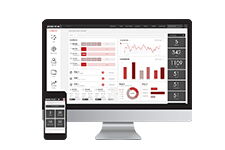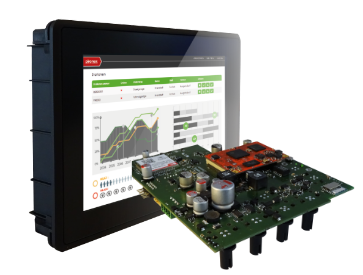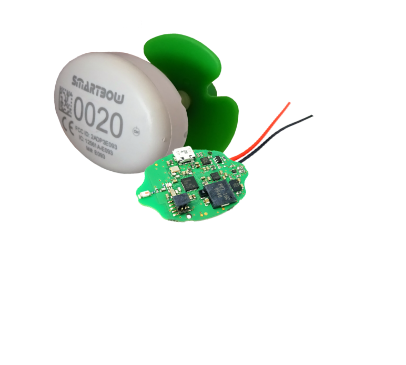Animal Husbandry & Agriculture

Wolf Deterrence vs. Info Management
Preventing Wolf Attacks

Smart Barns with IoT
Signal Feeding and Animal Welfare
Optimized workflows
In modern agriculture, technologies play an increasingly significant role. One of the most important innovations in recent years is GPS trackers combined with the ISOBUS system. These technological advances enable farmers to optimize their processes, increase efficiency, and use resources strategically.
The application of GPS trackers in agriculture has revolutionized operations. Through precise positioning, farmers can better coordinate their machinery and workflows. GPS trackers capture real-time data, enabling accurate field mapping and detailed planning of work steps. This ensures even field processing, leading to better yields. Additionally, GPS data allows for precise documentation and analysis of agricultural activities, contributing to the optimization of future work processes.


Precise fieldwork thanks to GPS tracking
A significant advantage of GPS trackers is precise fieldwork. Farmers can control machines with centimeter-level accuracy, avoiding overlaps and omissions, using cultivation areas more efficiently, and distributing seeds, fertilizers, and pesticides more evenly. This results in higher yields, better crop quality, and reduced operating costs, especially in large farms.

ISOBUS: The language of machines
An ISOBUS system allows operators to connect and control various devices through a single graphical terminal called a Universal Terminal (UT). This enables management of all compatible ISOBUS implements regardless of the manufacturer. This ISOBUS protocol represents an agreement among agricultural machinery and equipment manufacturers, resolving compatibility issues.

Saving resources and minimizing environmental impacts
The combination of GPS trackers and ISOBUS systems contributes to resource conservation. Thanks to precise control and monitoring, the application of fertilizers, pesticides, and seeds can be accurately dosed. This not only leads to cost savings but also reduces environmental impacts. By targeting the use of resources, soil fertility is maintained, and environmental pollution is minimized.

Future prospects and innovations
The technology surrounding GPS trackers and ISOBUS systems is continually evolving. New innovations such as the integration of artificial intelligence and machine learning hold the promise of further enhancing efficiency and accuracy. These advancements could potentially lead to autonomous machines operating fully automatically and with even greater precision in the future. This would enable farmers to save more time and resources while increasing productivity.
Wolf Deterrence vs. Information Management
A current problem in agriculture in Mecklenburg-Vorpommern is the conflict between humans and animals, in particular between humans and wolves.
On the one hand, nature should be protected and the wolf should be reintroduced to nature, but on the other hand this reintroduction affects the needs and interests of the people. Particularly those of farmers and shepherds, who are concerned about their livelihoods and are calling for the wolf population to be limited, as sheep are among the livestock most frequently killed by wolves.
Link to the "Innoherd" project website https://eip-herdenschutz.de/


Project Experience from Europe
As an innovative company, pironex is making its contribution. A collar for sheep equipped with LED lights and ultrasound was originally planned to deter wolves and prevent them from attacking. However, this has not proved to be particularly effective in practice.
We consider the installation of electrified fences to be the most effective method of protecting livestock. However, the installation and maintenance of these fences represents a considerable burden for farmers.

High-Quality Safety Fences Help
In view of this, the pironex engineers decided to focus on developing a device that is tailored to the needs and behaviour of the animals. Discussions with farmers and shepherds revealed that flocks of sheep become restless before a possible attack. This manifests itself in a change in the behaviour of the sheep, which, among other things, consume less food.

Shepherd will be informed
Based on this finding, we have developed a motion sensor that is attached to ten per cent of the sheep as a collar and interacts with other sensors on the pasture fence and a higher-level backend, the pironex-iot portal, via a LoRaWAN interface.
The portal also communicates with the shepherd's mobile device via the corresponding API interfaces. As part of the project, an Android app was developed that signals to the shepherd when there is a risk of a wolf attack.

Summary of the Solution
This solution allows the farmer to react promptly to a potential danger, check the condition of the fence and reinforce it if necessary to protect his herd.
pironex shows that innovative technologies can help to resolve conflicts between humans and animals and promote peaceful coexistence. It remains to be seen how the technology will develop and whether it will prove its worth in practice.
Radio and Control Technology in the Barn
Signal or prompt feeding helps to reduce stress for pigs living in a group. Rivalries and aggressions on the feeding system occur repeatedly when eating. Signal feeding is a method of teaching pigs to engage in response to a signal and proceed to the feeding trough.
The method is based on call or signal-based feed management. Individual signals are interpreted by animals as indicators for their own feeding. This signal is made up of acoustic signals or vibrations released by a pig's ear tag. As a result, the ear tag serves as both an actuator and a sensor. Movements of the pig are recorded and transmitted via close range radio (BT or 868 MHz) to the superior IPC unit. The IPC with display and touch piA-SF is the gateway between cloud and barn. This Linux terminal is designed for extremely harsh environments such as the pigsty.
The fully automatic feeding system in the pigsty in Dummerstorf (FBM) was developed to optimally feed pregnant pigs living in small groups. A fully automatic system was created that ensures a more rational use of the feed, determines optimal feeding times, ensures the needs-based supply of nutrients, vitamins and trace elements and, above all, minimizes animal fights at the trough.


Animal Welfare & Innovative Technology
The access control system is used to develop modern feeding stations and also to convert older feeding stations into modern feeding stations. An inexpensive way to ensure optimal feeding and stress reduction in the pigsty.
Modern technology can make a significant contribution to improving animal welfare in agricultural livestock farming. In order for it to be accepted by the target group, it must be reliable and, above all, intuitive to use.

Control Unit for Barn Systems
The system is based on our panel PC piA-SF with a 10.1" multi-touch display, which was specially developed for harsh environments with high humidity. The panel PC ensures continuous operation at a temperature of up to +60°C, is fanless and supports the following interfaces: CAN / CANOpen, Ethernet, WLAN, RS485, USB, GSM/UMTS/LTE. Accessories for antennas and fastening material are standardized for the Linux terminal.

Radio Module for Ear Tag
The sensor and transmitter unit is based on a BT LE or 868 MHz radio module. The electronics and software developed were integrated into an ear tag from Smartbow. All ear tags are optimized for the lowest energy consumption. In addition to the radio unit, a button cell supplies a buzzer and a vibration module. During normal operation, the ear tag is in a stand-by mode. If the higher-level control computer sends an activation signal by radio, the pig is activated by acoustic signals and the vibration motor.

Management-Software
Based on animal behaviour and known animal parameters such as age and body weight, the control program estimates the approximate rank of each pig in the social hierarchy of the group. The social rank is used to account for the natural feeding order in a series of calls, reducing feeding-related fights even further. The calculations are done directly in the Linux control computer and serve as the foundation for controlling the ear tags - sensor nodes.

GPS trackers in agriculture
Efficiency improvement through ISOBUS systems

Wolf Deterrence vs. Info Management
Preventing Wolf Attacks

Smart Barns with IoT
Signal Feeding and Animal Welfare
Optimized workflows
In modern agriculture, technologies play an increasingly significant role. One of the most important innovations in recent years is GPS trackers combined with the ISOBUS system. These technological advances enable farmers to optimize their processes, increase efficiency, and use resources strategically.
The application of GPS trackers in agriculture has revolutionized operations. Through precise positioning, farmers can better coordinate their machinery and workflows. GPS trackers capture real-time data, enabling accurate field mapping and detailed planning of work steps. This ensures even field processing, leading to better yields. Additionally, GPS data allows for precise documentation and analysis of agricultural activities, contributing to the optimization of future work processes.


Precise fieldwork thanks to GPS tracking
A significant advantage of GPS trackers is precise fieldwork. Farmers can control machines with centimeter-level accuracy, avoiding overlaps and omissions, using cultivation areas more efficiently, and distributing seeds, fertilizers, and pesticides more evenly. This results in higher yields, better crop quality, and reduced operating costs, especially in large farms.

ISOBUS: The language of machines
An ISOBUS system allows operators to connect and control various devices through a single graphical terminal called a Universal Terminal (UT). This enables management of all compatible ISOBUS implements regardless of the manufacturer. This ISOBUS protocol represents an agreement among agricultural machinery and equipment manufacturers, resolving compatibility issues.

Saving resources and minimizing environmental impacts
The combination of GPS trackers and ISOBUS systems contributes to resource conservation. Thanks to precise control and monitoring, the application of fertilizers, pesticides, and seeds can be accurately dosed. This not only leads to cost savings but also reduces environmental impacts. By targeting the use of resources, soil fertility is maintained, and environmental pollution is minimized.

Future prospects and innovations
The technology surrounding GPS trackers and ISOBUS systems is continually evolving. New innovations such as the integration of artificial intelligence and machine learning hold the promise of further enhancing efficiency and accuracy. These advancements could potentially lead to autonomous machines operating fully automatically and with even greater precision in the future. This would enable farmers to save more time and resources while increasing productivity.
Wolf Deterrence vs. Information Management
A current problem in agriculture in Mecklenburg-Vorpommern is the conflict between humans and animals, in particular between humans and wolves.
On the one hand, nature should be protected and the wolf should be reintroduced to nature, but on the other hand this reintroduction affects the needs and interests of the people. Particularly those of farmers and shepherds, who are concerned about their livelihoods and are calling for the wolf population to be limited, as sheep are among the livestock most frequently killed by wolves.
Link to the "Innoherd" project website https://eip-herdenschutz.de/


Project Experience from Europe
As an innovative company, pironex is making its contribution. A collar for sheep equipped with LED lights and ultrasound was originally planned to deter wolves and prevent them from attacking. However, this has not proved to be particularly effective in practice.
We consider the installation of electrified fences to be the most effective method of protecting livestock. However, the installation and maintenance of these fences represents a considerable burden for farmers.

High-Quality Safety Fences Help
In view of this, the pironex engineers decided to focus on developing a device that is tailored to the needs and behaviour of the animals. Discussions with farmers and shepherds revealed that flocks of sheep become restless before a possible attack. This manifests itself in a change in the behaviour of the sheep, which, among other things, consume less food.

Shepherd will be informed
Based on this finding, we have developed a motion sensor that is attached to ten per cent of the sheep as a collar and interacts with other sensors on the pasture fence and a higher-level backend, the pironex-iot portal, via a LoRaWAN interface.
The portal also communicates with the shepherd's mobile device via the corresponding API interfaces. As part of the project, an Android app was developed that signals to the shepherd when there is a risk of a wolf attack.

Summary of the Solution
This solution allows the farmer to react promptly to a potential danger, check the condition of the fence and reinforce it if necessary to protect his herd.
pironex shows that innovative technologies can help to resolve conflicts between humans and animals and promote peaceful coexistence. It remains to be seen how the technology will develop and whether it will prove its worth in practice.
Radio and Control Technology in the Barn
Signal or prompt feeding helps to reduce stress for pigs living in a group. Rivalries and aggressions on the feeding system occur repeatedly when eating. Signal feeding is a method of teaching pigs to engage in response to a signal and proceed to the feeding trough.
The method is based on call or signal-based feed management. Individual signals are interpreted by animals as indicators for their own feeding. This signal is made up of acoustic signals or vibrations released by a pig's ear tag. As a result, the ear tag serves as both an actuator and a sensor. Movements of the pig are recorded and transmitted via close range radio (BT or 868 MHz) to the superior IPC unit. The IPC with display and touch piA-SF is the gateway between cloud and barn. This Linux terminal is designed for extremely harsh environments such as the pigsty.
The fully automatic feeding system in the pigsty in Dummerstorf (FBM) was developed to optimally feed pregnant pigs living in small groups. A fully automatic system was created that ensures a more rational use of the feed, determines optimal feeding times, ensures the needs-based supply of nutrients, vitamins and trace elements and, above all, minimizes animal fights at the trough.


Animal Welfare & Innovative Technology
The access control system is used to develop modern feeding stations and also to convert older feeding stations into modern feeding stations. An inexpensive way to ensure optimal feeding and stress reduction in the pigsty.
Modern technology can make a significant contribution to improving animal welfare in agricultural livestock farming. In order for it to be accepted by the target group, it must be reliable and, above all, intuitive to use.

Control Unit for Barn Systems
The system is based on our panel PC piA-SF with a 10.1" multi-touch display, which was specially developed for harsh environments with high humidity. The panel PC ensures continuous operation at a temperature of up to +60°C, is fanless and supports the following interfaces: CAN / CANOpen, Ethernet, WLAN, RS485, USB, GSM/UMTS/LTE. Accessories for antennas and fastening material are standardized for the Linux terminal.

Radio Module for Ear Tag
The sensor and transmitter unit is based on a BT LE or 868 MHz radio module. The electronics and software developed were integrated into an ear tag from Smartbow. All ear tags are optimized for the lowest energy consumption. In addition to the radio unit, a button cell supplies a buzzer and a vibration module. During normal operation, the ear tag is in a stand-by mode. If the higher-level control computer sends an activation signal by radio, the pig is activated by acoustic signals and the vibration motor.

Management-Software
Based on animal behaviour and known animal parameters such as age and body weight, the control program estimates the approximate rank of each pig in the social hierarchy of the group. The social rank is used to account for the natural feeding order in a series of calls, reducing feeding-related fights even further. The calculations are done directly in the Linux control computer and serve as the foundation for controlling the ear tags - sensor nodes.